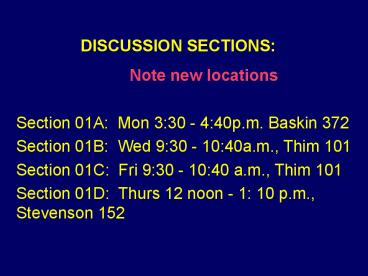Amino group needs to be excreted - PowerPoint PPT Presentation
1 / 22
Title:
Amino group needs to be excreted
Description:
Mercury in fish. Possible Issues. Bottom Line. Eat a variety of foods in moderation ... Get plenty of physical exercise. Talk about 'super-sizing' ... – PowerPoint PPT presentation
Number of Views:57
Avg rating:3.0/5.0
Title: Amino group needs to be excreted
1
DISCUSSION SECTIONS Note new locations
Section 01A Mon 330 - 440p.m. Baskin
372 Section 01B Wed 930 - 1040a.m., Thim
101 Section 01C Fri 930 - 1040 a.m., Thim
101 Section 01D Thurs 12 noon - 1 10 p.m.,
Stevenson 152
2
Outline for Today
- About the course
- Overview of Nutrition
- Healthy diets Nutrition and disease
- Nutrients
For your diet analysis project, start keeping a
detailed record of everything you eat and drink
for at least three days. Activate your CPS
connection
3
4
Class web page URL
http//chemistry.ucsc.edu/Faculty/Fink/80A-2004/20
04index.htm
5
Goals of the course
- To provide you with background in the
fundamentals of the science of nutrition,
sufficient to allow you to make your own critical
judgments as far as many nutritional claims are
concerned - To provide the basic facts concerning sound
dietary habits to allow you to plan and obtain
adequate nutrition for yourself. - How to find good sources of nutritional
information - How new scientific information is obtained
- Diet analysis project before and after
6
About the course
- Goals of the course
- Issue-based approach
- CPS interactive system
- General introduction to nutrition and current
issues - TEXT Contemporary Nutrition by G. Wardlaw, 5th
edition - GRADE BASED ON Weekly Quizzes (25), Midterm
(30), Final Exam (35), Diet analysis (10) - Discussion sections See UCSC class schedule.
Note The quizzes will be given in the discussion
sections. Start next week. - Readings Please read the appropriate chapter in
Wardlaw prior to the lecture (see schedule).
Please also read the controversies at the end of
the chapters. - The class web page has information about the
class, lecture outlines, links to useful sites,
class notices, etc.
7
Possible Issues
- Weight control and dieting e. g. low carb diets
- Obesity, eating disorders
- Healthy diets
- Nutrition and disease
- Food Safety, Mad Cow Disease
- Vegetarian diets
- Supplements
- GM Foods
- Mercury in fish
8
Bottom Line
- Eat a variety of foods in moderation
- Eat lots of fruits and vegetables
- Minimize saturated (animal) fats
- Minimize fats and calories
- Get plenty of physical exercise
9
Talk about super-sizing
Most of you have an energy requirement of
2000-3500 Cals/day
10
Talk about super-sizing contd.
11
Nutrition is
- the science of food, the nutrients and the
substances therein, their action, interaction,
and balance in relation to health and disease,
and the process by which the organism ingests,
absorbs, transport, utilizes, and excretes food
substances----The Council on Food and Nutrition
of the American Medical Association
12
Nutrients Come from Food
- Provide energy to fuel our bodies
- Provide building blocks for new tissue
- Vital for growth and maintenance
- Some are essential i. e. we cant make them (or
enough) and so must get them from our diets
13
Nutrition and Health
- Poor diet and sedentary lifestyle increase the
risk for chronic diseases - Disease of the heart (31 of all deaths)
- Cancer (23)
- Cerebrovascular disease (7)
- Diabetes (3)
14
(No Transcript)
15
(No Transcript)
16
The Six Classes of Nutrients
- Carbohydrates
- Fats
- Proteins
- Vitamins
- Minerals
- Water
Essential nutrients Nonessential nutrients
17
Nutrients Come from Food
FOOD DIGESTION / ABSORPTION NUTRIENTS
PROCESSING / METABOLISM (converts the basic
nutrients into many other needed chemicals /
biochemicals)
18
DIGESTION, ABSORPTION
Large molecules Polysaccharides, proteins,
triglycerides
Enzymes (digestion)
Small molecules Monosaccharides, amino acids,
fatty acids
Absorption
Small molecules in the blood, to liver, muscles,
neurons etc.
19
ESSENTIAL NUTRIENTS
20
Energy Yielding Nutrients
- Carbohydrates 4 kcal/gm
- Protein 4 kcal/gm
- Fat 9 kcal/gm
- (Alcohol 7 kcal/gm)
- Adjusted for digestibility
- Account for substances (in food) not available
for energy use
21
Carbohydrates
- Composed of C, H, O
- Provide a major source of fuel for the body
- Basic unit is monosaccharide (glucose)
- Simple and Complex CHO
- Energy yielding (4 kcal /gm)
22
(No Transcript)































